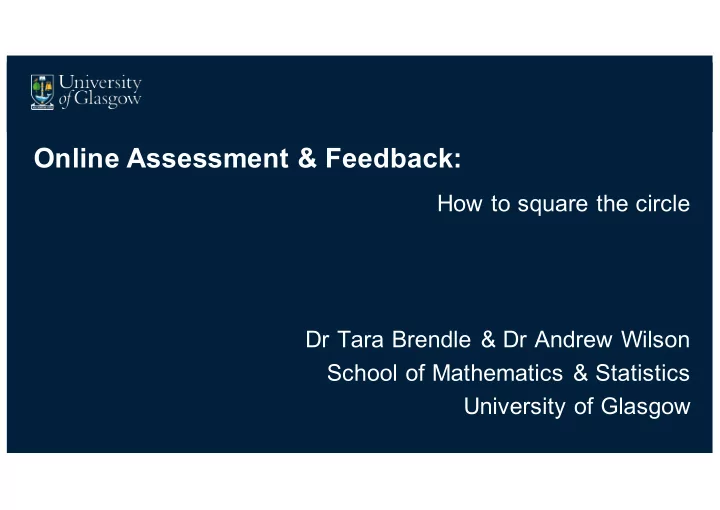

Online Assessment & Feedback: How to square the circle Dr Tara Brendle & Dr Andrew Wilson School of Mathematics & Statistics University of Glasgow
The Problem • Level 2 Mathematics: • Level 1 Mathematics: – over 400 students – over 700 students – 8 modules – 4 modules – each week 80 tutorial – each week 50 tutorial groups meeting groups meeting
The Problem • Not enough feedback to students – Level 1 (Maths 1R): • 4 workshops • One class test – Level 2: • Only a single piece of work with 3-4 questions (the Class Test) was marked and returned – Plenty of formative assessment, but limited opportunity for feedback
The Problem Feedback given had no demonstrable positive effect: – Class tests returned near end of semester – Poor attendance during class test weeks – Class test disrupted learning; students disengaged with course
The Problem: No positive effect from class test 2C results (first sitting) 2011-12 2C results (first sitting) 2012-13 30 30 25 25 20 20 Class test mark (/30) Class test mark (/30) 15 15 10 10 5 5 0 0 0 10 20 30 40 50 60 0 10 20 30 40 50 60 Degree exam mark (/60) Degree exam mark (/60)
The Solution: Increasing feedback, not workload • Over 2,000 individually assessed pieces of work per week • Integration of technology and assessment: – e-assessment software: WebAssign – Scanning technology: written assignments • Efficiencies: team work – School office – IT – Academic staff
The Solution: Efficient teamwork
The Solution: Live SharePoint database
The Results: What our students say
The Results: Time-on-task
The Results: Student grades
New in Level 1: ‘just-in-time’ teaching philosophy ‘provide[s] a good way to understand the parts of the course that need more care when delivered to students, and to better shape tutorials.’ Level 1 Lecturer & Tutor
New in Level 1: ‘just-in-time’ teaching philosophy Monday • short online T/F quiz completed • questions designed to – foster conceptual change – highlight concepts students may be struggling with – encourage student-student & student-faculty interactions
New in Level 1: ‘just-in-time’ teaching philosophy Feedback Tuesday • Q18 (false) For any real angle θ, (sinθ, cosθ) are • Provide Feedback to Students, the coordinates of the point P θ on the unit circle. Owch! The responses to this question were split 50- Tutors & Lecturers 50. Firstly recall that these questions are based on the lecture notes, so you needed to read through these to – results & analysis (see left) shared find the definition of P θ as the point with argument θ via Moodle forum direct to all and modulus 1 . Secondly, this is very close to the definition of the sine and cosine functions for all – further feedback on problem areas angles. To show that this statement is false it is for students enough to draw a quick sketch of a right angled triangle with hypotenuse 1 and other side lengths – teaching staff have ‘finger on pulse’ determined by the 'coordinates' given in the question – you will quickly see that this statement cannot be true in general.
New in Level 1: ‘just-in-time’ teaching philosophy Wednesday • Tutorials & lectures enriched and enhanced – tutors address issues in tutorials – increased student-student & student-faculty interactions (even faculty-faculty!) – lecturers can revisit problem areas in later lectures
What Next? • Ongoing review of student support for e-assessment – GTAs staffing email aliases – ‘ask-your-teacher’ feature (bad idea) – coordinating with Student Learning Service – eliminate errors in e-assessment to alleviate student frustrations • Use of scanning technology in exams – Currently used on our ‘small’ Level 1 course (12 multiple-choice questions) — rolling this out to other courses is under consideration.
What Next? • Identify non-engaged students and intervening • Providing Advisers of Studies with actionable information • Tailoring interventions accordingly • Student retention
Reflections: What have we learned? • We produce large volumes of data — interrogate it! • We can square the circle — increasing feedback without increasing workload — but this requires: – Efficient teamwork – Integration of technology – Enthusiasm
Recommend
More recommend